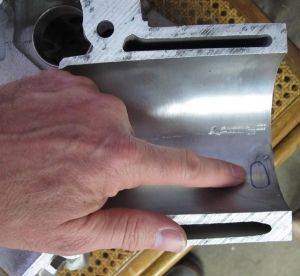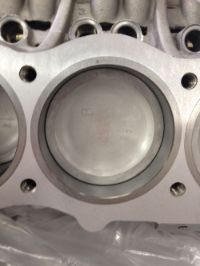Keeping it more simple,

:-
My first V8 was a manual 3500S, and was stock. It was fairly quick and very smooth. I didn't have it that long and is stayed as stock throughout its life with me.
I had a white V8 auto for a while and to be honest, it wasn't very good at all. I remember testing my cars for outright power by blasting at top speed up a long hill near where I lived at the time. The manual was around 85mph, and the auto only ever managed 77mph, even though I tried several times. I do think it may have been more down to the engine tune than the box.
Then Thunderdog came along and he got to 88mph on the first test, he was quick, and felt lively. After a few mods, (SD1 Heads, AAA needles, Mike the pipe 4:2:1 headers, 30% lightened flywheel, SD1 dizzy, and a 5 speed box) he managed 97mph

. I actually managed an indicated 140mph once along a very long (private

) road in Somerset. great fun to drive and I kept the car for many years.
All of the above were 3528cc
Then Sparky came along.
The spec for this car was reported to be - New 4 litre cross bolted V8. Pair of stage 1 unleaded RPI engineering cylinder heads. Piper RP4 high torque cam and followers. New rocker shafts. Steel rockers. Cloyes duplex timing chain and sprockets. New oil pump. New water pump. Lightened (35%) and balanced flywheel. New 3 piece clutch. New clutch master and slave cylinders(didn't last long). High torque gear reduction starter motor. Mallory dual point distributor (changed for an SD1 electronic Dizzy). RPI engineering A&P electronic ignition power amp. Correct ignition coil and ballast resistor(12V coil no ballast ?). Magnecor 8mm plug leads. Offenhauser dual port inlet manifold. Weber 500 carburettor. K&N air filter. Facet red top fuel pump. Malpassi fuel pressure regulator. J&P stainless exhaust manifolds with 1 3/4" primaries. Custom 2 into 1 front section of exhaust. JR Wadhams high capacity 3 row radiator (only has two rows ?) Kenlowe electric radiator fan (changed for a 14" fan controlled by a revotec sensor). Stripped and rebuilt LT77 5 speed gearbox (yeah right :shock: ).
Ooerr :shock:
Problem was, when I got him, was that the engine was badly installed and ran like a bag of nails. Most of it was down to the electrical system which seemed to be based on little blue scotch clips and hope. That is how Sparky got his name :shock:
I did rewire it, and then replaced the dizzy as the huge amount of under bonnet heat had damaged it. He then went a fair bit better.
I spent so much time on other things that I never really got the best out of the engine, but I did replace the melted engine mounts, have a complete stainless exhaust made up for him, wrapped the manifolds in a vain attempt to remove the heat problem, then had them ceramic coated inside and out, changed the Dizzy for the SD1 unit, rebuilt the gearbox, and cleaned and painted some bits.
I now do have a calibration kit now, and have read up on the carb. I have rebuilt it with new gaskets and jets, etc and was getting some good results with the power coming on strong from around 1,500 rpm and revving cleanly up the 5,200. It does move very well and I would recommend the upgrade. I actually bought Sparky with all that kit listed above, but I don't know if I would have paid out for it all. I have bills for £6,500 for the engine and gearbox :shock: :? .
I don't have access to Sparky at the moment for reasons I won't be going into, but will be updating the progress as and when

Richard





